Ravenhill 5% of Christians in America Born Again

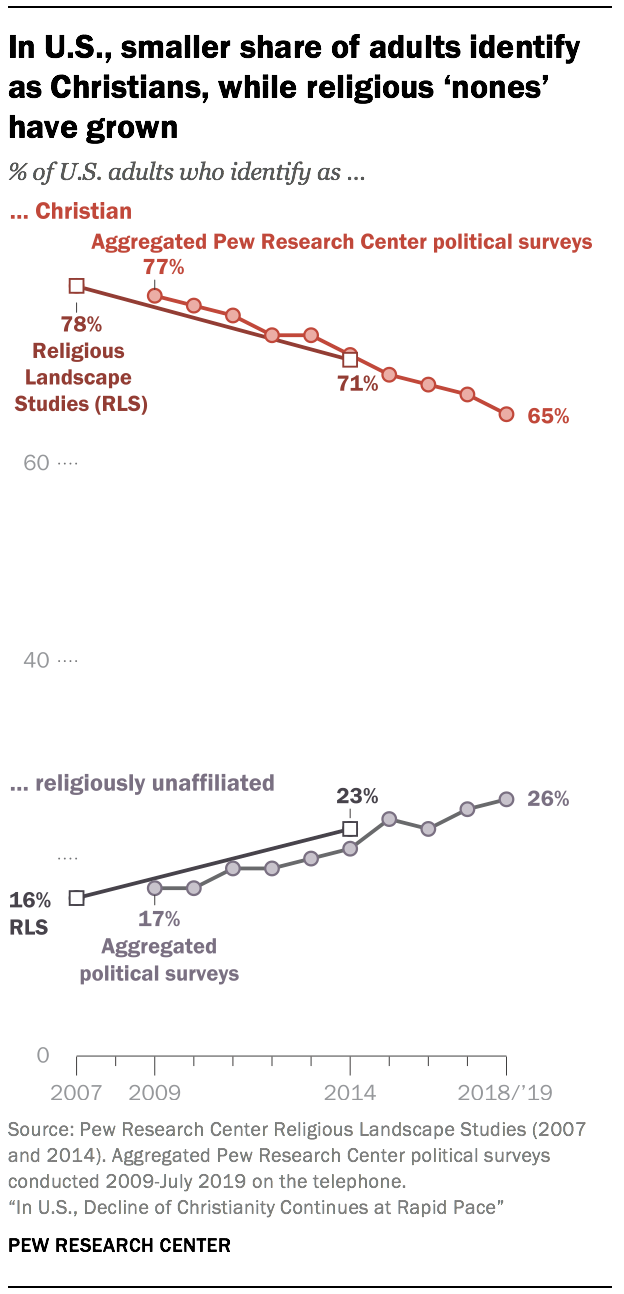 The religious landscape of the United States continues to change at a rapid clip. In Pew Enquiry Eye telephone surveys conducted in 2018 and 2019, 65% of American adults depict themselves as Christians when asked about their organized religion, down 12 percentage points over the past decade. Meanwhile, the religiously unaffiliated share of the population, consisting of people who describe their religious identity as atheist, agnostic or "aught in item," at present stands at 26%, up from 17% in 2009.
The religious landscape of the United States continues to change at a rapid clip. In Pew Enquiry Eye telephone surveys conducted in 2018 and 2019, 65% of American adults depict themselves as Christians when asked about their organized religion, down 12 percentage points over the past decade. Meanwhile, the religiously unaffiliated share of the population, consisting of people who describe their religious identity as atheist, agnostic or "aught in item," at present stands at 26%, up from 17% in 2009.
Both Protestantism and Catholicism are experiencing losses of population share. Currently, 43% of U.Due south. adults identify with Protestantism, down from 51% in 2009. And one-in-five adults (xx%) are Catholic, down from 23% in 2009. Meanwhile, all subsets of the religiously unaffiliated population – a group too known equally religious "nones" – have seen their numbers swell. Self-described atheists now account for iv% of U.Southward. adults, up modestly just significantly from 2% in 2009; agnostics make up v% of U.Southward. adults, upwardly from iii% a decade ago; and 17% of Americans at present draw their religion every bit "goose egg in detail," up from 12% in 2009. Members of not-Christian religions also take grown modestly equally a share of the developed population.
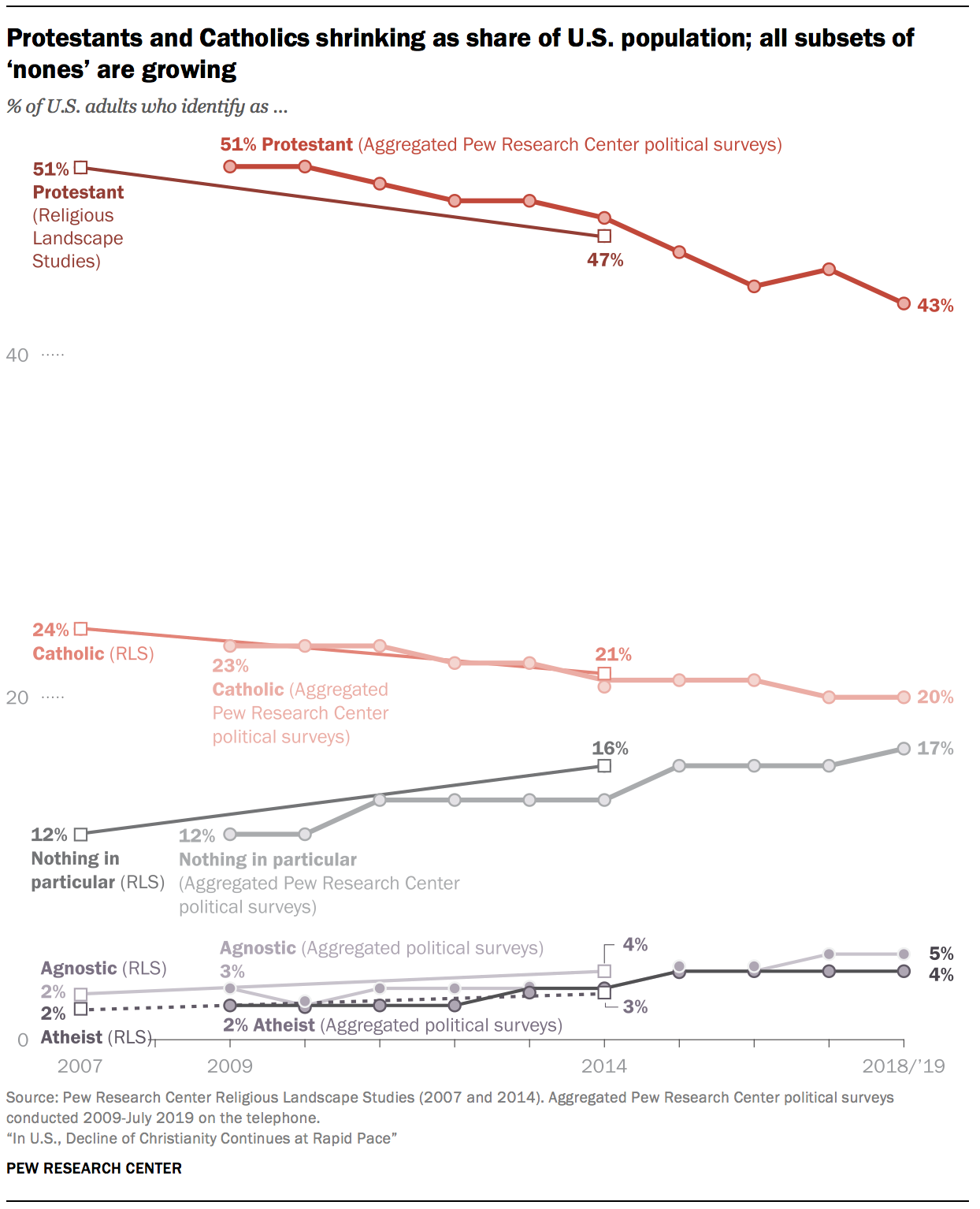
These are amidst the fundamental findings of a new analysis of trends in the religious limerick and churchgoing habits of the American public, based on recent Pew Research Middle random-digit-dial (RDD) political polling on the telephone.1 The information shows that the trend toward religious disaffiliation documented in the Centre's 2007 and 2014 Religious Landscape Studies, and before that in major national studies similar the Full general Social Survey (GSS), has connected rapidly.
Pew Inquiry Centre's 2007 and 2014 Religious Mural Studies were huge national RDD surveys, each of which included interviews with more than 35,000 respondents who were asked dozens of detailed questions about their religious identities, behavior and practices. The Center has not yet conducted a third such study, and when the Mural Study is repeated, it is likely to use new methods that may preclude information technology from being directly comparable to the previous studies; growing challenges to conducting national surveys by phone take led the Heart to rely increasingly on cocky-administered surveys conducted online.2
But while no new Religious Landscape Report is available or in the immediate offing, the Centre has collected five additional years of information (since the 2014 Mural Study) from RDD political polls (see detailed tables). The samples from these political polls are not as large as the Landscape Studies (even when all of the political polls conducted in a yr are combined), but together, 88 surveys from 2009 to 2019 included interviews with 168,890 Americans.
These surveys do non include nearly as many questions about religion as the Landscape Studies do. However, as part of the demographic battery of questions that ask respondents about their age, race, educational attainment and other groundwork characteristics, each of these political polls also include i basic question about religious identity – "What is your nowadays religion, if any? Are y'all Protestant, Roman Catholic, Mormon, Orthodox such as Greek or Russian Orthodox, Jewish, Muslim, Buddhist, Hindu, atheist, agnostic, something else, or nix in detail?"
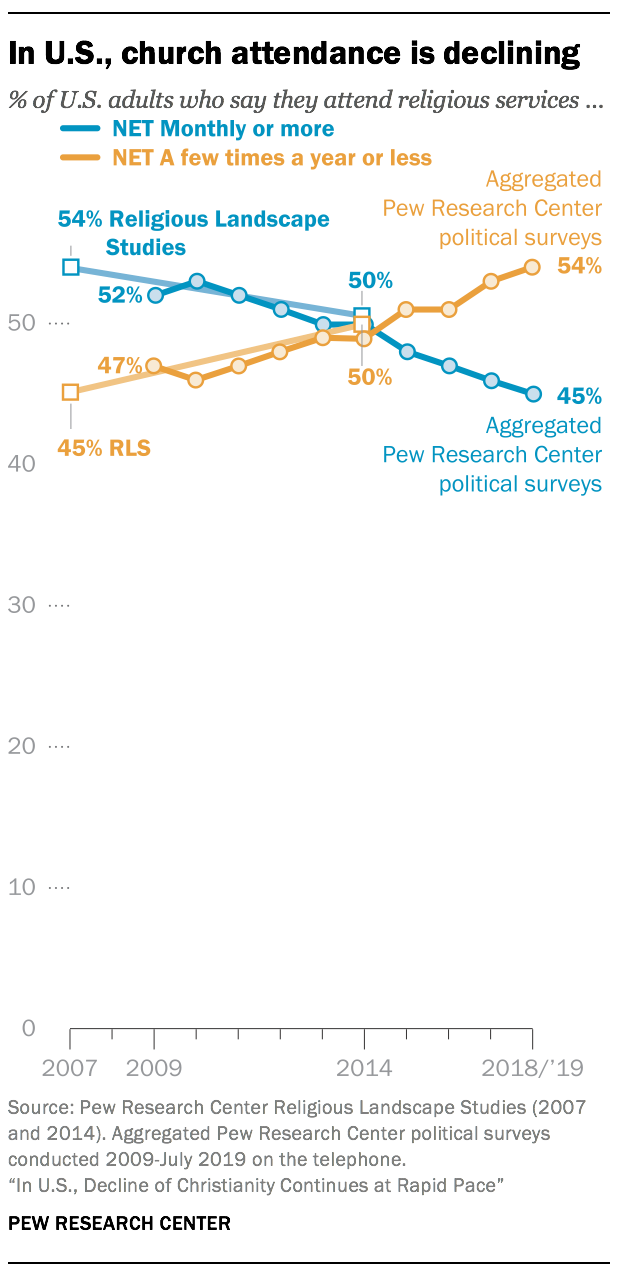 Additionally, most of these political polls include a question nigh religious attendance – "Aside from weddings and funerals, how often practise yous nourish religious services? More once a week, once a week, once or twice a month, a few times a year, seldom, or never?" Taken together, these two questions (1 about religious identity, the other about religious omnipresence) can help shed light on religious trends in the U.Due south.
Additionally, most of these political polls include a question nigh religious attendance – "Aside from weddings and funerals, how often practise yous nourish religious services? More once a week, once a week, once or twice a month, a few times a year, seldom, or never?" Taken together, these two questions (1 about religious identity, the other about religious omnipresence) can help shed light on religious trends in the U.Due south.
The information shows that just like rates of religious amalgamation, rates of religious attendance are declining.3 Over the terminal decade, the share of Americans who say they attend religious services at least once or twice a calendar month dropped by vii per centum points, while the share who say they attend religious services less often (if at all) has risen past the aforementioned degree. In 2009, regular worship attenders (those who attend religious services at least one time or twice a calendar month) outnumbered those who attend services merely occasionally or not at all by a 52%-to-47% margin. Today those figures are reversed; more Americans now say they attend religious services a few times a year or less (54%) than say they attend at least monthly (45%).
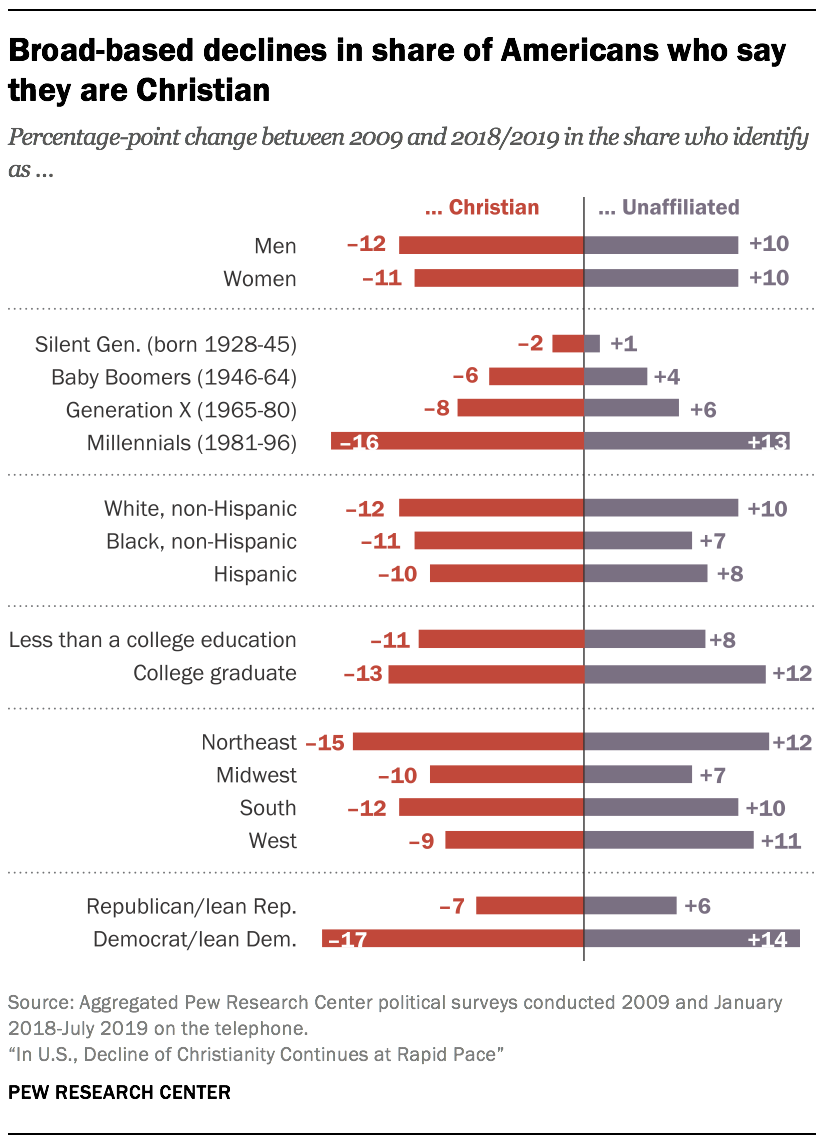 The changes underway in the American religious landscape are wide-based. The Christian share of the population is downward and religious "nones" have grown beyond multiple demographic groups: white people, black people and Hispanics; men and women; in all regions of the country; and among college graduates and those with lower levels of educational attainment. Religious "nones" are growing faster among Democrats than Republicans, though their ranks are swelling in both partisan coalitions. And although the religiously unaffiliated are on the ascension amidst younger people and nearly groups of older adults, their growth is almost pronounced among young adults.
The changes underway in the American religious landscape are wide-based. The Christian share of the population is downward and religious "nones" have grown beyond multiple demographic groups: white people, black people and Hispanics; men and women; in all regions of the country; and among college graduates and those with lower levels of educational attainment. Religious "nones" are growing faster among Democrats than Republicans, though their ranks are swelling in both partisan coalitions. And although the religiously unaffiliated are on the ascension amidst younger people and nearly groups of older adults, their growth is almost pronounced among young adults.
Furthermore, the data shows a wide gap between older Americans (Baby Boomers and members of the Silent Generation) and Millennials in their levels of religious affiliation and attendance. More than eight-in-x members of the Silent Generation (those born between 1928 and 1945) describe themselves equally Christians (84%), as do three-quarters of Baby Boomers (76%). In stark contrast, only half of Millennials (49%) depict themselves as Christians; four-in-ten are religious "nones," and one-in-10 Millennials identify with non-Christian faiths.
Only most 1-in-three Millennials say they nourish religious services at least once or twice a month. Roughly 2-thirds of Millennials (64%) attend worship services a few times a year or less often, including virtually 4-in-ten who say they seldom or never become. Indeed, in that location are as many Millennials who say they "never" nourish religious services (22%) as there are who say they go at least once a week (22%).
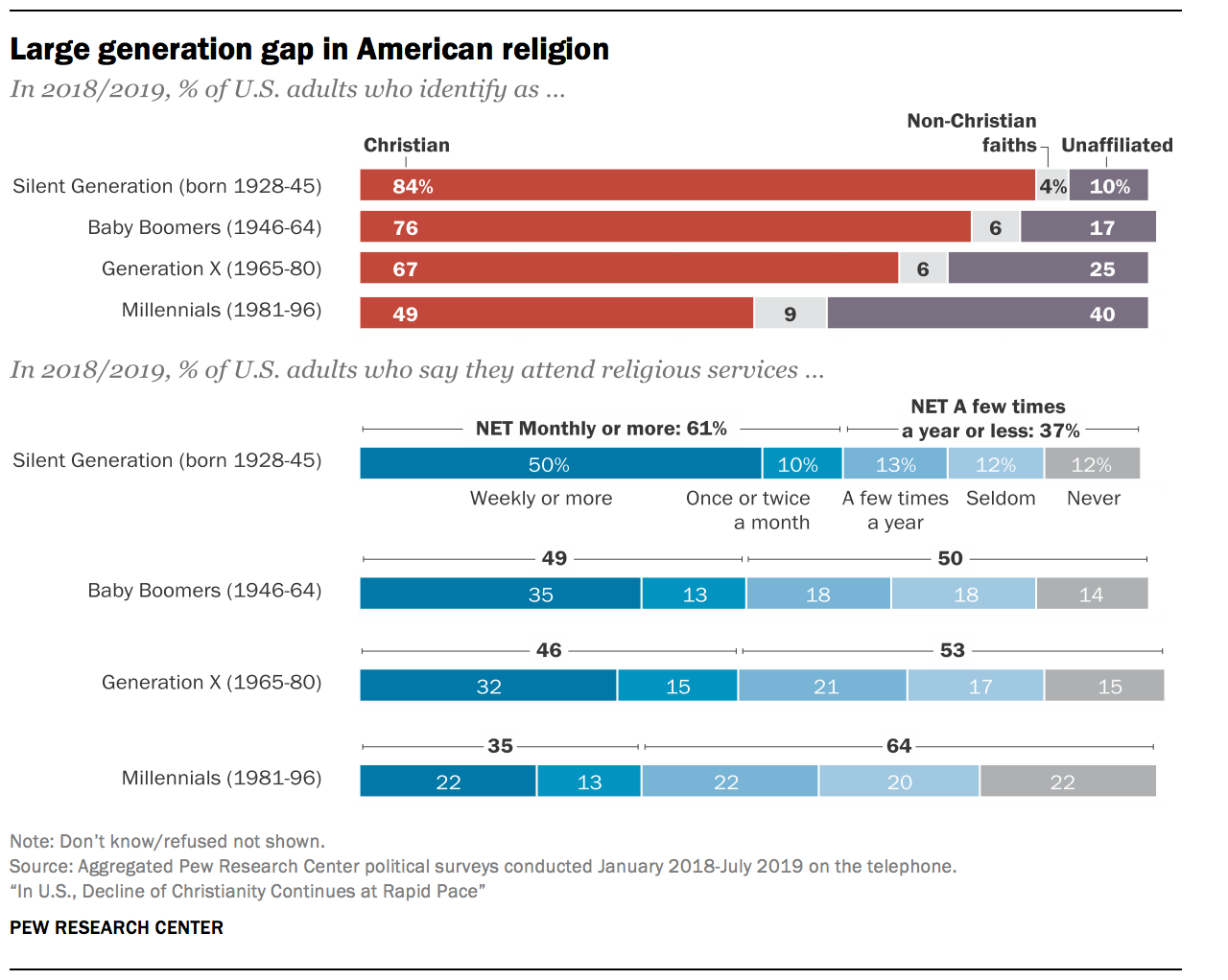
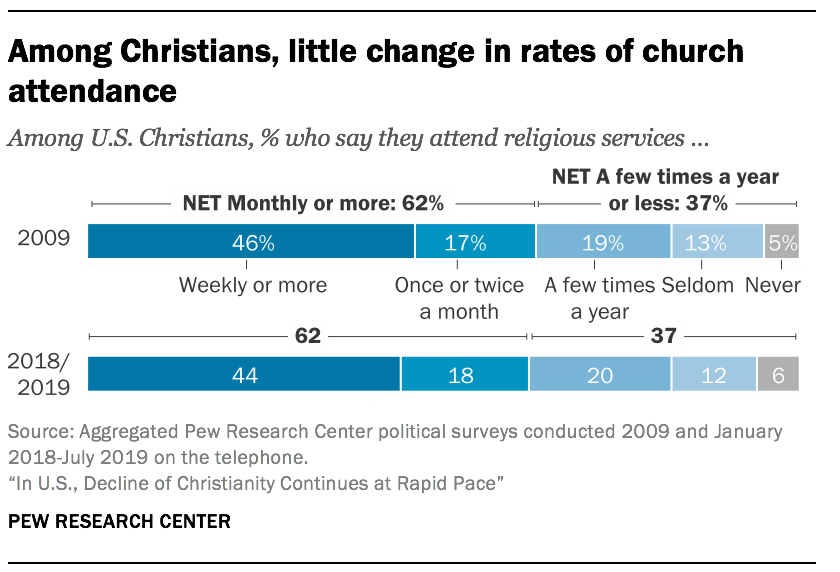 While the trends are articulate – the U.Southward. is steadily condign less Christian and less religiously observant every bit the share of adults who are not religious grows – self-described Christians report that they attend religious services at about the aforementioned rate today as in 2009. Today, 62% of Christians say they attend religious services at least once or twice a month, which is identical to the share who said the same in 2009. In other words, the nation's overall rate of religious attendance is declining not considering Christians are attention church less often, but rather because there are now fewer Christians as a share of the population.
While the trends are articulate – the U.Southward. is steadily condign less Christian and less religiously observant every bit the share of adults who are not religious grows – self-described Christians report that they attend religious services at about the aforementioned rate today as in 2009. Today, 62% of Christians say they attend religious services at least once or twice a month, which is identical to the share who said the same in 2009. In other words, the nation's overall rate of religious attendance is declining not considering Christians are attention church less often, but rather because there are now fewer Christians as a share of the population.
Other key takeaways from the new analysis include:
-
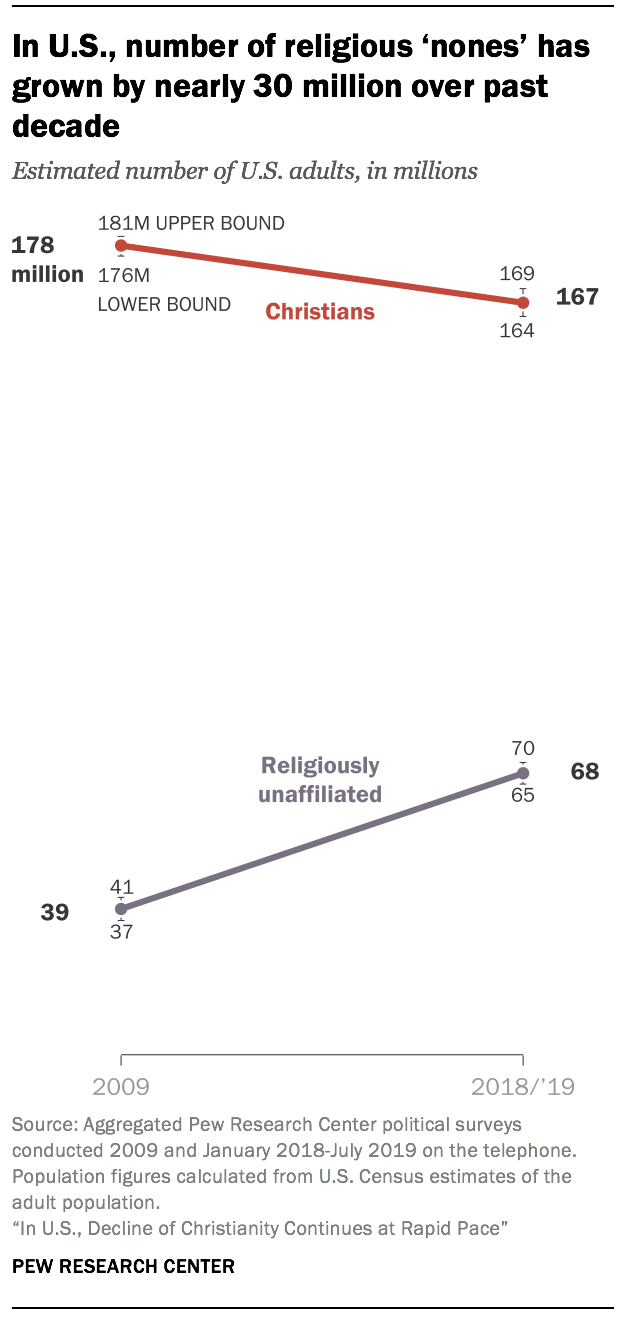 The information suggests that Christians are declining not only as a share of the U.South. developed population, only besides in absolute numbers. In 2009, there were approximately 233 million adults in the U.Southward., according to the Demography Agency. Pew Research Heart'due south RDD surveys conducted at the time indicated that 77% of them were Christian, which means that by this mensurate, there were approximately 178 1000000 Christian adults in the U.Southward. in 2009. Taking the margin of mistake of the surveys into account, the number of adult Christians in the U.S. every bit of 2009 could have been equally depression as 176 million or as high as 181 million.
The information suggests that Christians are declining not only as a share of the U.South. developed population, only besides in absolute numbers. In 2009, there were approximately 233 million adults in the U.Southward., according to the Demography Agency. Pew Research Heart'due south RDD surveys conducted at the time indicated that 77% of them were Christian, which means that by this mensurate, there were approximately 178 1000000 Christian adults in the U.Southward. in 2009. Taking the margin of mistake of the surveys into account, the number of adult Christians in the U.S. every bit of 2009 could have been equally depression as 176 million or as high as 181 million.
Today, there are roughly 23 million more adults in the U.S. than there were in 2009 (256 million as of July 1, 2019, co-ordinate to the Demography Bureau). About ii-thirds of them (65%) identify as Christians, according to 2018 and 2019 Pew Enquiry Center RDD estimates. This means that at that place are now roughly 167 million Christian adults in the U.Southward. (with a lower bound of 164 million and an upper bound of 169 meg, given the survey'south margin of error).
Meanwhile, the number of religiously unaffiliated adults in the U.S. grew by well-nigh 30 million over this menstruation.
-
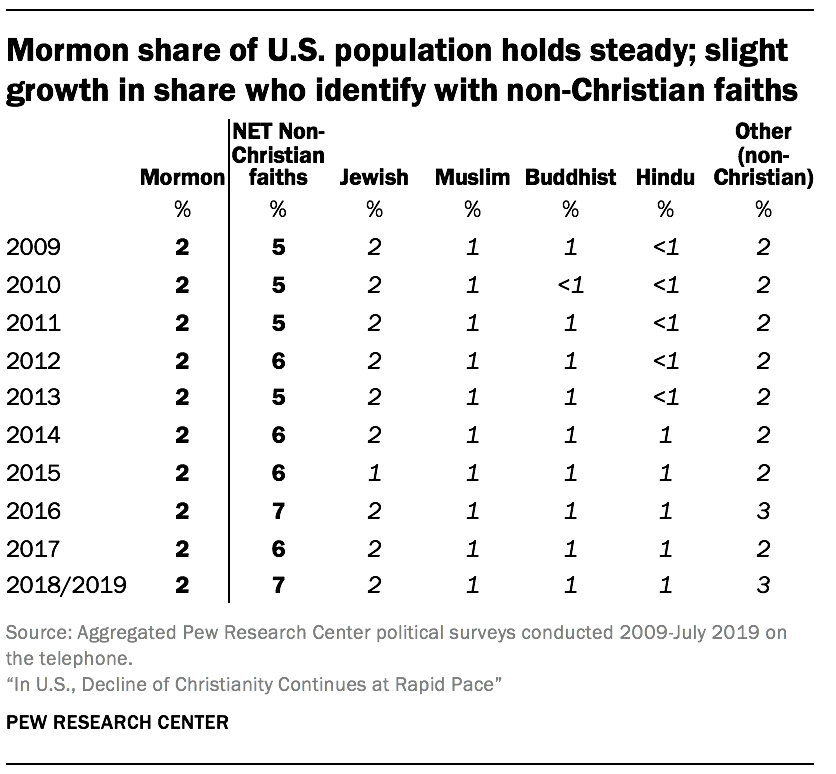 The share of Americans who draw themselves every bit Mormons has held steady at two% over the past decade.4 Meanwhile, the share of U.S. adults who identify with non-Christian faiths has ticked up slightly, from five% in 2009 to 7% today. This includes a steady 2% of Americans who are Jewish, along with 1% who are Muslim, 1% who are Buddhist, 1% who are Hindu, and 3% who identify with other faiths (including, for instance, people who say they bide past their own personal religious beliefs and people who describe themselves as "spiritual")five
The share of Americans who draw themselves every bit Mormons has held steady at two% over the past decade.4 Meanwhile, the share of U.S. adults who identify with non-Christian faiths has ticked up slightly, from five% in 2009 to 7% today. This includes a steady 2% of Americans who are Jewish, along with 1% who are Muslim, 1% who are Buddhist, 1% who are Hindu, and 3% who identify with other faiths (including, for instance, people who say they bide past their own personal religious beliefs and people who describe themselves as "spiritual")five -
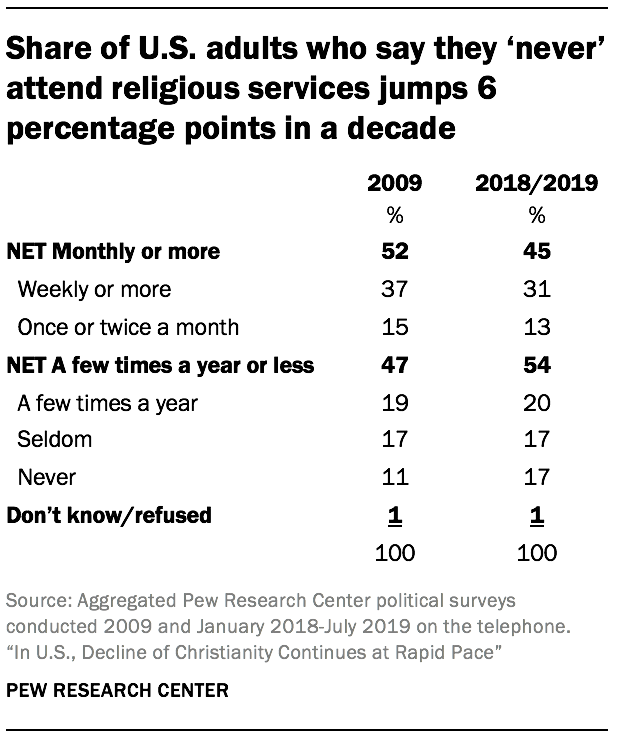 The rise share of Americans who say they nourish religious services no more than a few times a twelvemonth (if at all) has been driven by a substantial jump in the proportion who say they "never" become to church building. Today, 17% of Americans say they never attend religious services, up from 11% a decade ago. Similarly, the turn down in regular churchgoing is attributable mainly to the shrinking share of Americans who say they attend religious services at least in one case a week, which was 37% in 2009 and now stands at 31%.
The rise share of Americans who say they nourish religious services no more than a few times a twelvemonth (if at all) has been driven by a substantial jump in the proportion who say they "never" become to church building. Today, 17% of Americans say they never attend religious services, up from 11% a decade ago. Similarly, the turn down in regular churchgoing is attributable mainly to the shrinking share of Americans who say they attend religious services at least in one case a week, which was 37% in 2009 and now stands at 31%. -
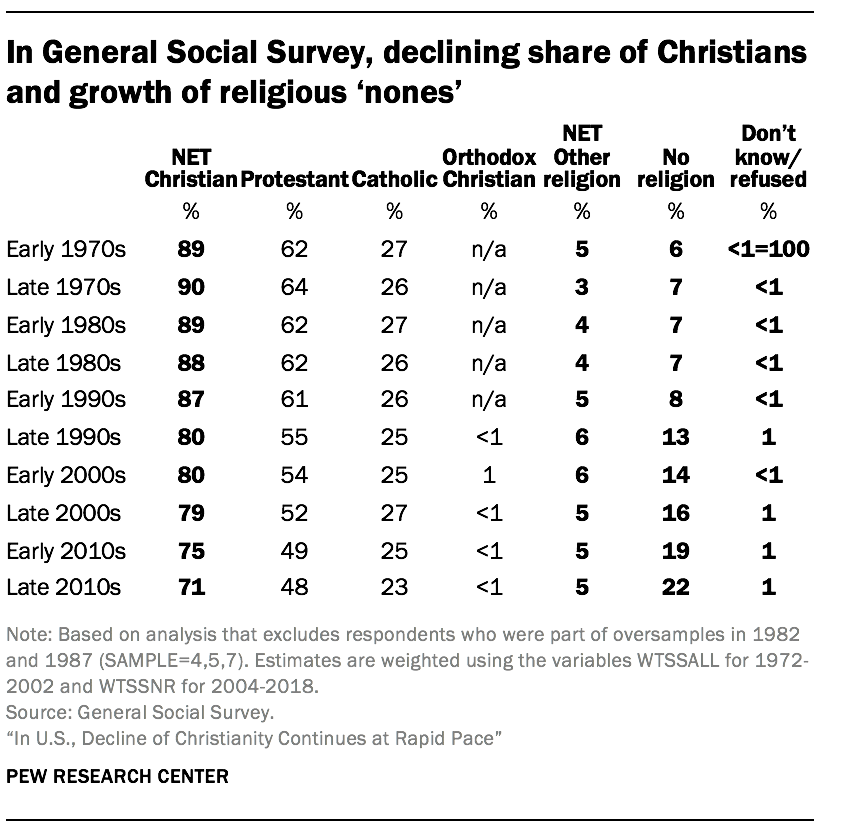 The trends documented in Pew Research Centre surveys closely resemble those found in the long-running General Social Survey (GSS), a project of the independent research organisation NORC at the University of Chicago, with main funding from the National Science Foundation. In GSS surveys conducted in the early 2000s (2000 to 2004), eighty% of U.South. adults identified as Christians, including 54% who described themselves equally Protestants and 25% who were Catholic. By the late 2010s, 71% of GSS respondents described themselves equally Christians (48% Protestant, 23% Cosmic). Over the same period, the GSS found that religious "nones" grew from 14% of the U.S. developed population to 22%.
The trends documented in Pew Research Centre surveys closely resemble those found in the long-running General Social Survey (GSS), a project of the independent research organisation NORC at the University of Chicago, with main funding from the National Science Foundation. In GSS surveys conducted in the early 2000s (2000 to 2004), eighty% of U.South. adults identified as Christians, including 54% who described themselves equally Protestants and 25% who were Catholic. By the late 2010s, 71% of GSS respondents described themselves equally Christians (48% Protestant, 23% Cosmic). Over the same period, the GSS found that religious "nones" grew from 14% of the U.S. developed population to 22%.
The point estimates from the GSS and Pew Research Heart surveys (that is, the share of adults who identify as Protestant or Catholic or equally religious "nones") are not directly comparable; the two studies ask different questions and employ different modes of survey administration. But the fact that the direction of the trend is like in both studies strongly suggests that both are picking upwards on real and significant alter underway in the U.S. religious landscape.
These findings nearly the religious composition of Hispanics closely resemble those from Pew Enquiry Center's National Surveys of Latinos (NSL) – a nationally representative survey of U.Southward. Latino adults fielded almost every twelvemonth. (See the detailed tables for consummate trends in the religious composition of Hispanics based on both Pew Research Center political surveys and the NSL.)
-
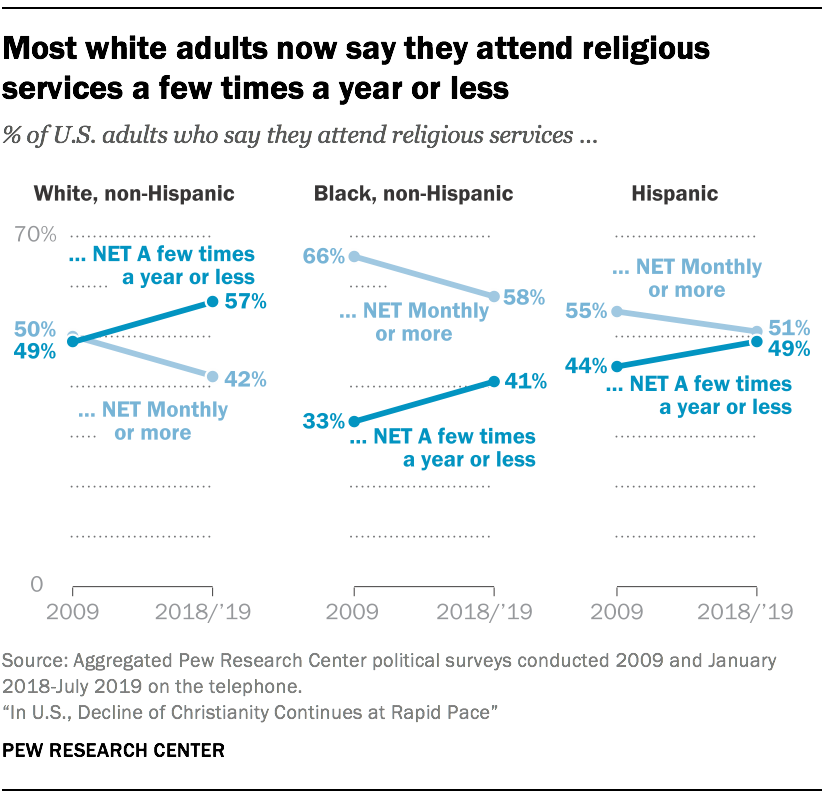 Among white adults, the share of people who say they nourish religious services a few times a year or less now exceeds the share who attend monthly or more than (57% vs. 42%); a decade ago, the white population was evenly divided between those who went to church building at least monthly and those who did not. Regular churchgoers withal outnumber those who infrequently or never get to religious services among black Americans (58% vs. 41%), though the share of people who say they nourish religious services a few times a year or less often has risen over the concluding decade among black Americans, just as information technology has amongst the population as a whole. U.South. Hispanics are now about evenly divided betwixt those who say they attend religious services at least once or twice a calendar month (51%) and those who say they nourish a few times a year or less (49%).
Among white adults, the share of people who say they nourish religious services a few times a year or less now exceeds the share who attend monthly or more than (57% vs. 42%); a decade ago, the white population was evenly divided between those who went to church building at least monthly and those who did not. Regular churchgoers withal outnumber those who infrequently or never get to religious services among black Americans (58% vs. 41%), though the share of people who say they nourish religious services a few times a year or less often has risen over the concluding decade among black Americans, just as information technology has amongst the population as a whole. U.South. Hispanics are now about evenly divided betwixt those who say they attend religious services at least once or twice a calendar month (51%) and those who say they nourish a few times a year or less (49%). -
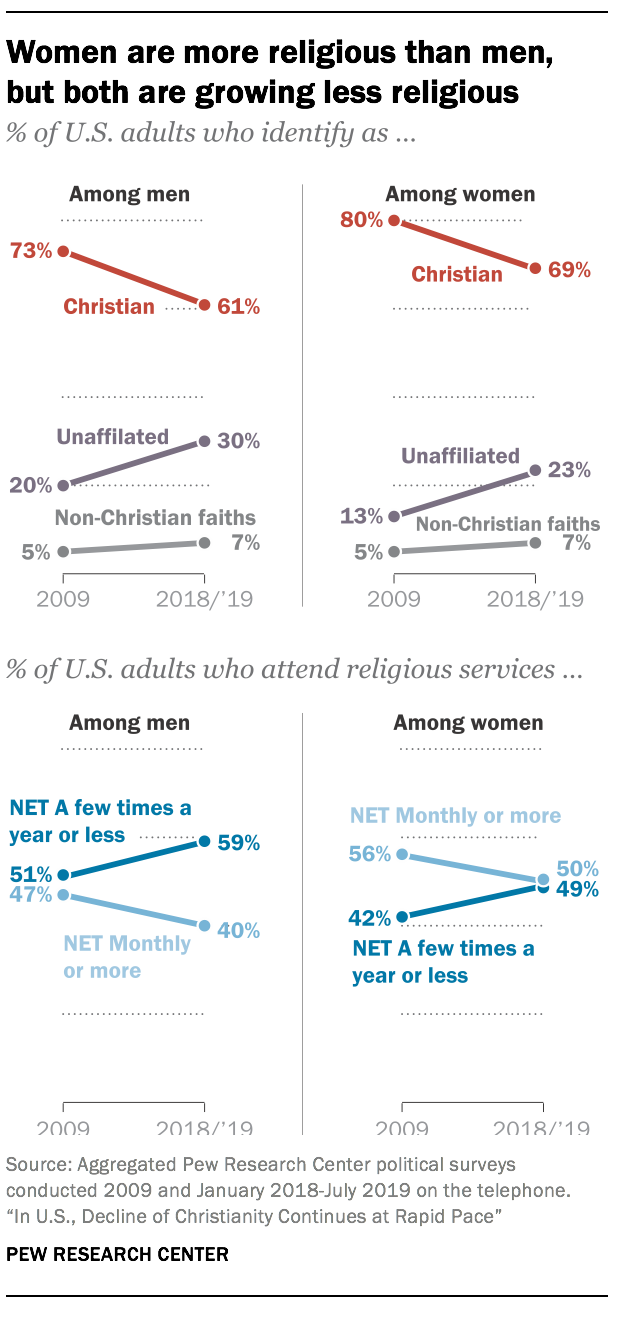 There is however a gender gap in American faith. Women are less likely than men to depict themselves every bit religious "nones" (23% vs. 30%), and more likely than men to say they nourish religious services at to the lowest degree once or twice a month (fifty% vs. 40%). But women, like men, have grown noticeably less religious over the last decade. The share of "nones" amid women has risen by 10 percentage points since 2009 – similar to the increase among men. And the share of women who identify equally Christian has fallen by 11 points (from fourscore% to 69%) over that same catamenia.
There is however a gender gap in American faith. Women are less likely than men to depict themselves every bit religious "nones" (23% vs. 30%), and more likely than men to say they nourish religious services at to the lowest degree once or twice a month (fifty% vs. 40%). But women, like men, have grown noticeably less religious over the last decade. The share of "nones" amid women has risen by 10 percentage points since 2009 – similar to the increase among men. And the share of women who identify equally Christian has fallen by 11 points (from fourscore% to 69%) over that same catamenia. - Christians have declined and "nones" take grown every bit a share of the adult population in all iv major U.S. regions. Catholic losses have been most pronounced in the Northeast, where 36% identified every bit Catholic in 2009, compared with 27% today. Amidst Protestants, declines were larger in the Due south, where Protestants now account for 53% of the adult population, downward from 64% in 2009.
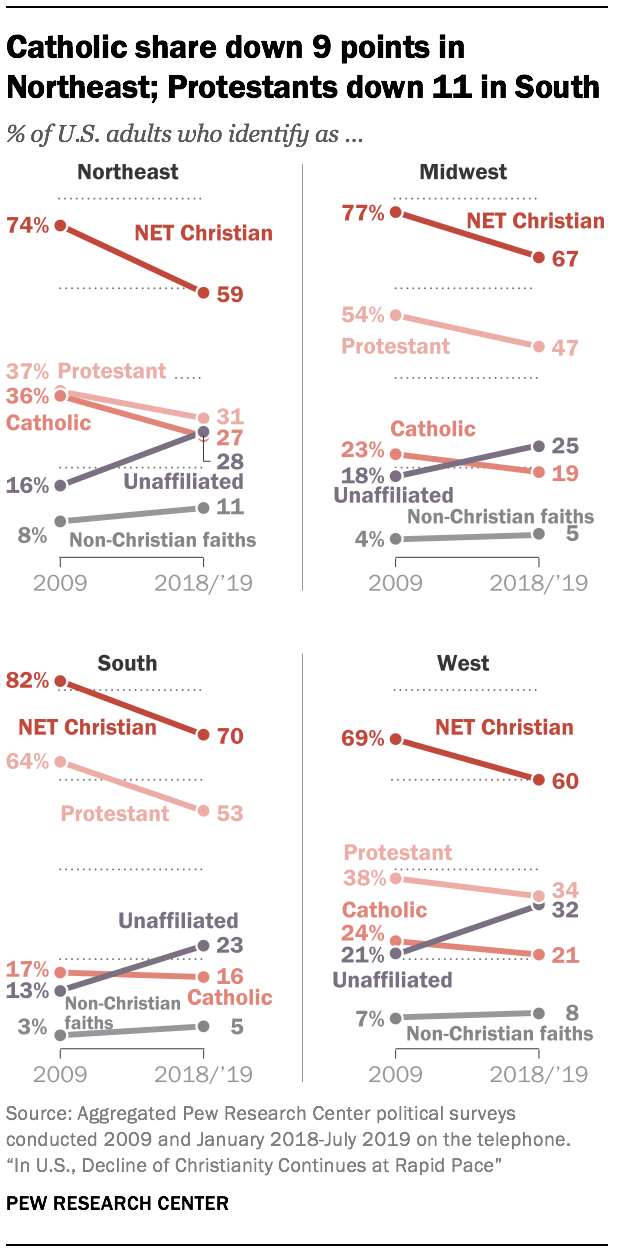
- Religious "nones" now make up fully 1-third of Democrats. And near six-in-ten people who identify with or lean toward the Democratic Party say they attend religious services no more than than a few times a yr. The ranks of religious "nones" and infrequent churchgoers also are growing within the Republican Political party, though they make upwardly smaller shares of Republicans than Democrats.
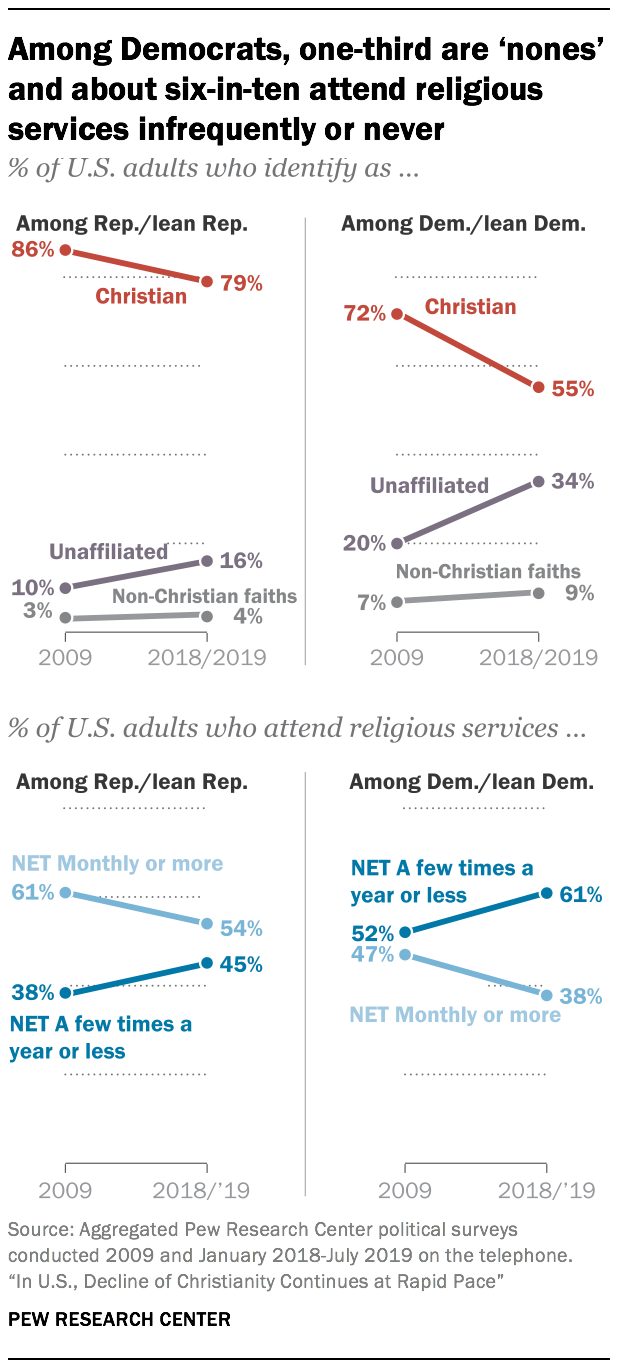
- The religious profile of white Democrats is very unlike from the religious profile of racial and ethnic minorities inside the Democratic Party. Today, fewer than half of white Democrats describe themselves as Christians, and just three-in-ten say they regularly attend religious services. More than than 4-in-ten white Democrats are religious "nones," and fully 7-in-ten white Democrats say they attend religious services no more than a few times a yr. Black and Hispanic Democrats are far more likely than white Democrats to describe themselves as Christians and to say they attend religious services regularly, though all three groups are becoming less Christian.
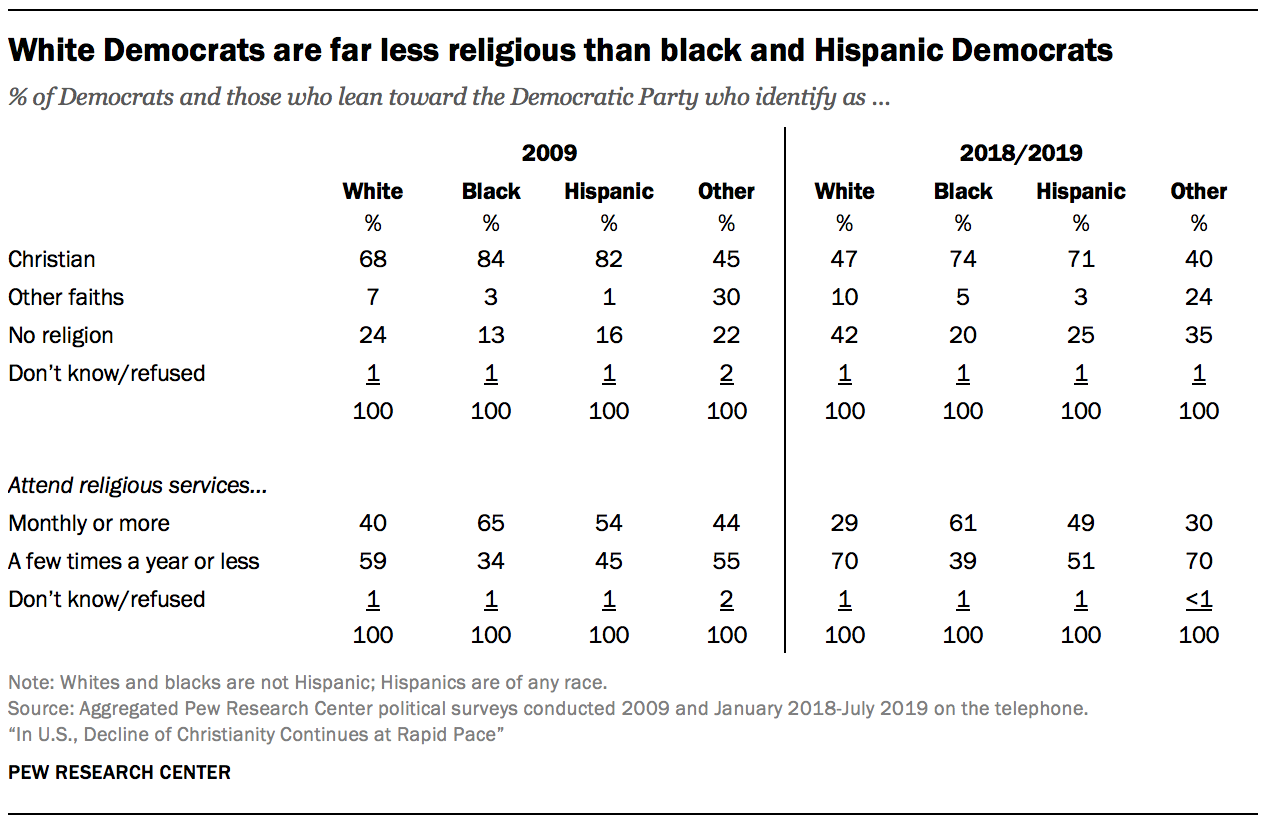
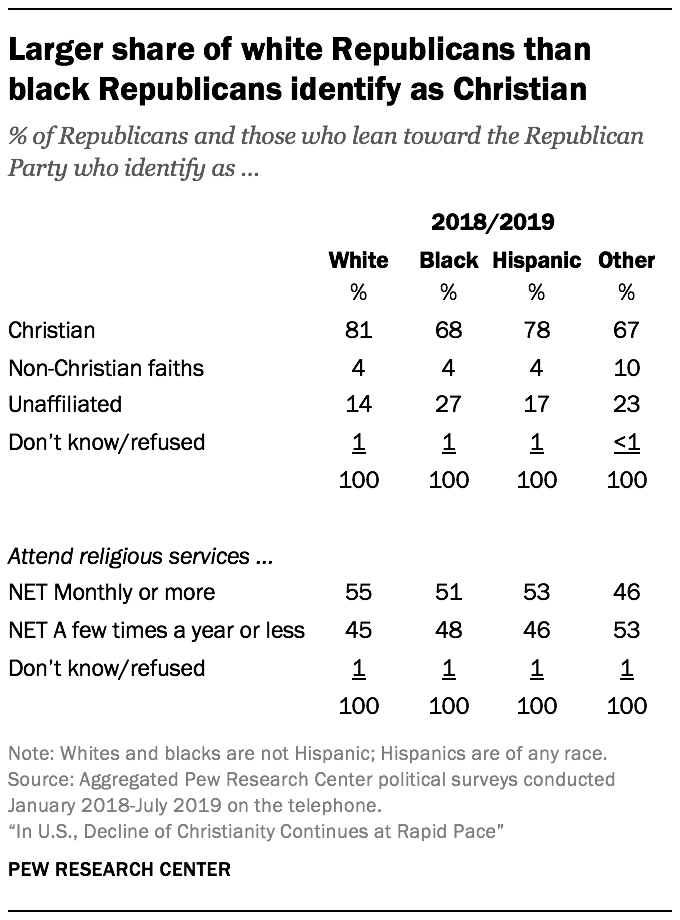 Although 2009 surveys did not include enough blackness Republicans to analyze separately, the nigh recent surveys bear witness smaller religious differences by race and ethnicity among Republicans than Democrats.
Although 2009 surveys did not include enough blackness Republicans to analyze separately, the nigh recent surveys bear witness smaller religious differences by race and ethnicity among Republicans than Democrats. -
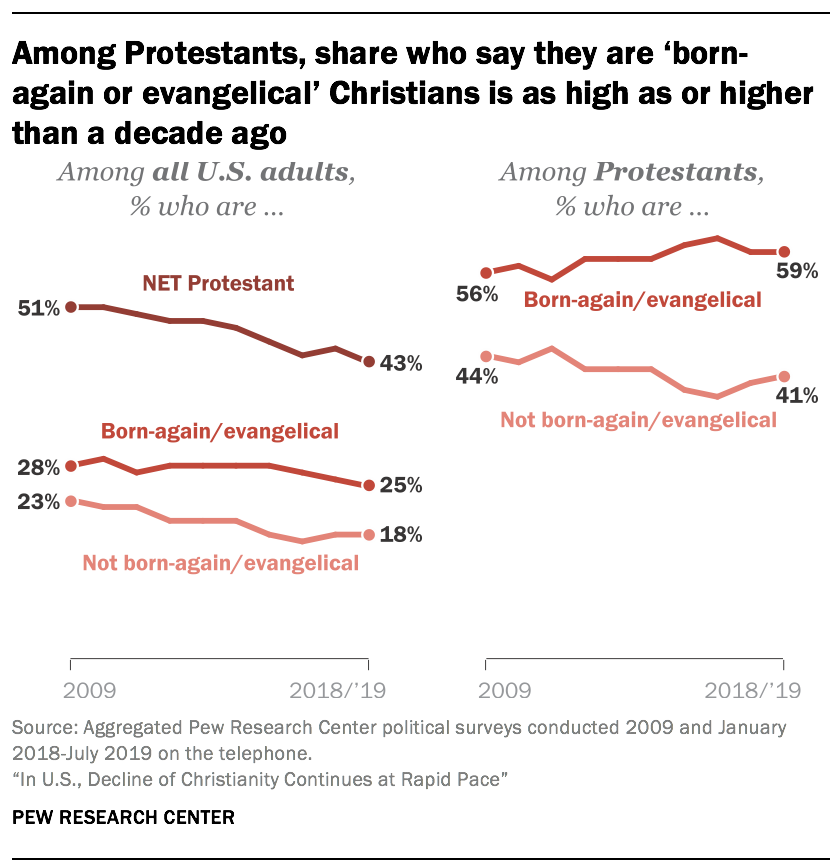 Pew Research Center'southward telephone political polls do non typically include the detailed questions that are needed to determine whether Protestants place with denominations in the evangelical, mainline or historically black Protestant tradition. However, the political polls upon which this analysis is based practice ask Protestants whether they recollect of themselves as "built-in-again or evangelical" Christians. The data shows that both Protestants who draw themselves equally born-again or evangelical Christians and Protestants who are non born-again or evangelical have declined as a share of the overall U.S. adult population, reflecting the country'southward broader shift away from Christianity as a whole. However, looking only at Americans who identify as Protestants – rather than at the public as a whole – the share of all Protestants who are built-in-once more or evangelical is at to the lowest degree as high today as it was in 2009.
Pew Research Center'southward telephone political polls do non typically include the detailed questions that are needed to determine whether Protestants place with denominations in the evangelical, mainline or historically black Protestant tradition. However, the political polls upon which this analysis is based practice ask Protestants whether they recollect of themselves as "built-in-again or evangelical" Christians. The data shows that both Protestants who draw themselves equally born-again or evangelical Christians and Protestants who are non born-again or evangelical have declined as a share of the overall U.S. adult population, reflecting the country'southward broader shift away from Christianity as a whole. However, looking only at Americans who identify as Protestants – rather than at the public as a whole – the share of all Protestants who are built-in-once more or evangelical is at to the lowest degree as high today as it was in 2009. -
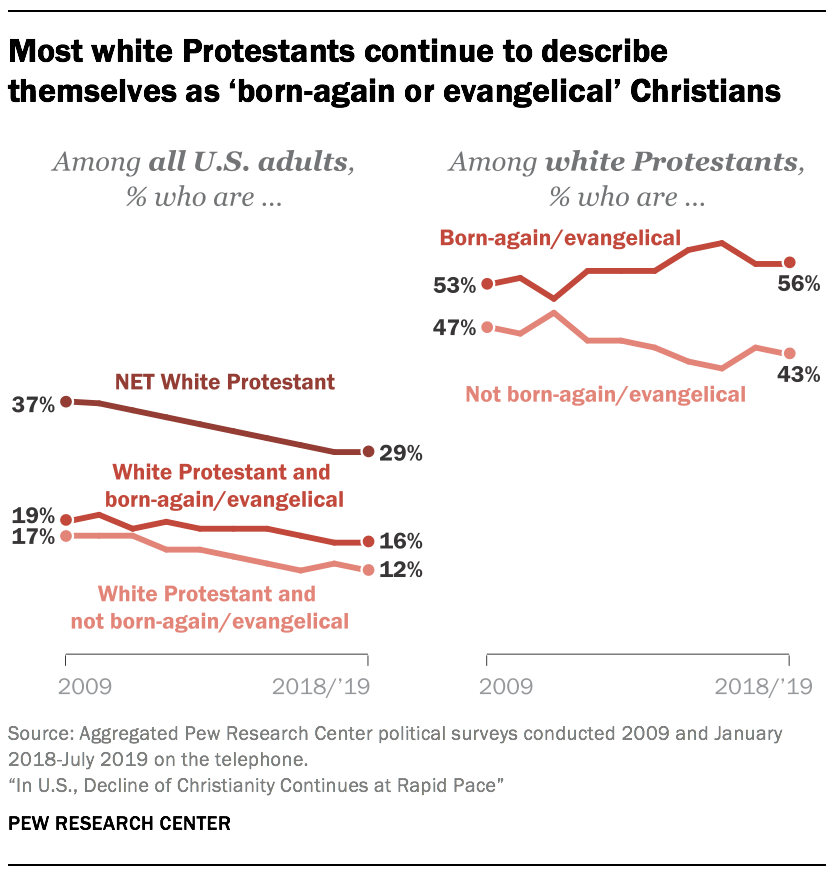 The share of U.S. adults who are white born-once again or evangelical Protestants now stands at 16%, downwards from 19% a decade ago. The shrinking white evangelical share of the population reflects both demographic changes that have occurred in the United States (where white people constitute a failing share of the population) and broader religious changes in American society (where the share of all adults who identify with Christianity has declined). However, looking only at white Protestants – rather than at the public as a whole – the share of white Protestants who depict themselves every bit born-once more or evangelical Christians is at least as high as information technology was a decade ago.
The share of U.S. adults who are white born-once again or evangelical Protestants now stands at 16%, downwards from 19% a decade ago. The shrinking white evangelical share of the population reflects both demographic changes that have occurred in the United States (where white people constitute a failing share of the population) and broader religious changes in American society (where the share of all adults who identify with Christianity has declined). However, looking only at white Protestants – rather than at the public as a whole – the share of white Protestants who depict themselves every bit born-once more or evangelical Christians is at least as high as information technology was a decade ago.
For complete data about trends in the religious composition and worship attendance habits of the U.Southward. public, see detailed tables.
wrightstentartudge.blogspot.com
Source: https://www.pewresearch.org/religion/2019/10/17/in-u-s-decline-of-christianity-continues-at-rapid-pace/
0 Response to "Ravenhill 5% of Christians in America Born Again"
Post a Comment